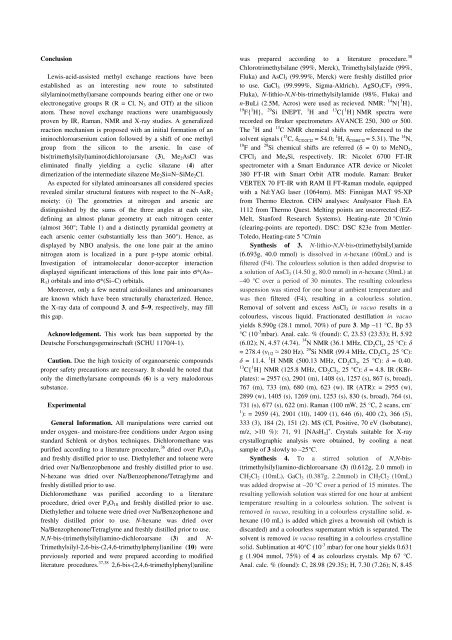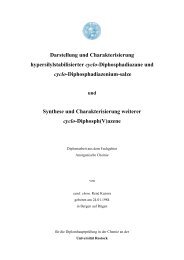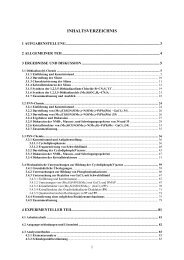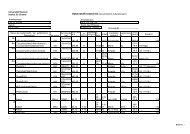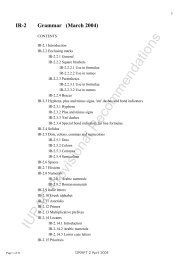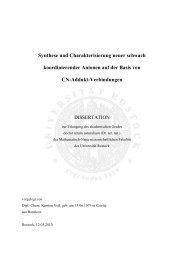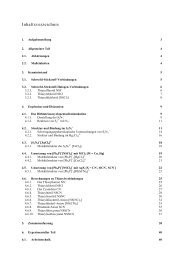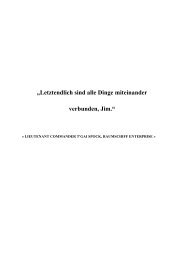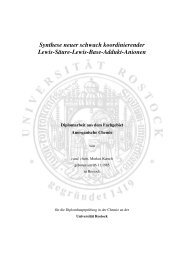Conclusion Lewis-acid-assisted methyl exchange reactions have been established as an interesting new route to substituted silylamino(methyl)arsane compo<strong>und</strong>s bearing either one or two electronegative groups R (R = Cl, N3 and OTf) at the silicon atom. These novel exchange reactions were unambiguously proven by IR, Raman, NMR and X-ray studies. A generalized reaction mechanism is proposed with an initial formation of an iminochloroarsenium cation followed by a shift of one methyl group from the silicon to the arsenic. In case of bis(trimethylsilyl)amino(dichloro)arsane (3), Me2AsCl was eliminated finally yielding a cyclic silazane (4) after dimerization of the intermediate silazene Me 2Si=N–SiMe 2Cl. As expected for silylated aminoarsanes all considered species revealed similar structural features with respect to the N–AsR 2 moiety: (i) The geometries at nitrogen and arsenic are distinguished by the sums of the three angles at each site, defining an almost planar geometry at each nitrogen center (almost 360°; Table 1) and a distinctly pyramidal geometry at each arsenic center (substantially less than 360°). Hence, as displayed by NBO analysis, the one lone pair at the amino nitrogen atom is localized in a pure p-type atomic orbital. Investigation of intramolecular donor-acceptor interaction displayed significant interactions of this lone pair into σ*(As– R 1) orbitals and into σ*(Si–C) orbitals. Moreover, only a few neutral azidosilanes and aminoarsanes are known which have been structurally characterized. Hence, the X-ray data of compo<strong>und</strong> 3, and 5–9, respectively, may fill this gap. Acknowledgement. This work has been supported by the Deutsche Forschungsgemeinschaft (SCHU 1170/4-1). Caution. Due the high toxicity of organoarsenic compo<strong>und</strong>s proper safety precautions are necessary. It should be noted that only the dimethylarsane compo<strong>und</strong>s (6) is a very malodorous substance. Experimental General Information. All manipulations were carried out <strong>und</strong>er oxygen- and moisture-free conditions <strong>und</strong>er Argon using standard Schlenk or drybox techniques. Dichloromethane was purified according to a literature procedure, 36 dried over P4O10 and freshly distilled prior to use. Diethylether and toluene were dried over Na/Benzophenone and freshly distilled prior to use. N-hexane was dried over Na/Benzophenone/Tetraglyme and freshly distilled prior to use. Dichloromethane was purified according to a literature procedure, dried over P4O10 and freshly distilled prior to use. Diethylether and toluene were dried over Na/Benzophenone and freshly distilled prior to use. N-hexane was dried over Na/Benzophenone/Tetraglyme and freshly distilled prior to use. N,N-bis-(trimethylsilyl)amino-dichloroarsane (3) and N- Trimethylsilyl-2,6-bis-(2,4,6-trimethylphenyl)aniline (10) were previously reported and were prepared according to modified literature procedures. 37,38 2,6-bis-(2,4,6-trimethylphenyl)aniline was prepared according to a literature procedure. 38 Chlorotrimethylsilane (99%, Merck), Trimethylsilylazide (99%, Fluka) and AsCl3 (99.99%, Merck) were freshly distilled prior to use. GaCl 3 (99.999%, Sigma-Aldrich), AgSO 3CF 3 (99%, Fluka), N-lithio-N,N-bis-trimethylsilylamide (98%, Fluka) and n-BuLi (2.5M, Acros) were used as recieved. NMR: 14 N{ 1 H}, 19 F{ 1 H}, 29 Si INEPT, 1 H and 13 C{ 1 H} NMR spectra were recorded on Bruker spectrometers AVANCE 250, 300 or 500. The 1 H and 13 C NMR chemical shifts were referenced to the solvent signals ( 13 C, δ CD2Cl2 = 54.0; 1 H, δ CDHCl2 = 5.31). The 14 N, 19 F and 29 Si chemical shifts are referred (δ = 0) to MeNO2, CFCl3 and Me4Si, respectively. IR: Nicolet 6700 FT-IR spectrometer with a Smart Endurance ATR device or Nicolet 380 FT-IR with Smart Orbit ATR module. Raman: Bruker VERTEX 70 FT-IR with RAM II FT-Raman module, equipped with a Nd:YAG laser (1064nm). MS: Finnigan MAT 95-XP from Thermo Electron. CHN analyses: Analysator Flash EA 1112 from Thermo Quest. Melting points are uncorrected (EZ- Melt, Stanford Research Systems). Heating-rate 20 °C/min (clearing-points are reported). DSC: DSC 823e from Mettler- Toledo, Heating-rate 5 °C/min Synthesis of 3. N-lithio-N,N-bis-(trimethylsilyl)amide (6.693g, 40.0 mmol) is dissolved in n-hexane (60mL) and is filtered (F4). The colourless solution is then added dropwise to a solution of AsCl 3 (14.50 g, 80.0 mmol) in n-hexane (30mL) at –40 °C over a period of 30 minutes. The resulting colourless suspension was stirred for one hour at ambient temperature and was then filtered (F4), resulting in a colourless solution. Removal of solvent and excess AsCl 3 in vacuo results in a colourless, viscous liquid. Fractionated destillation in vacuo yields 8.590g (28.1 mmol, 70%) of pure 3. Mp –11 °C, Bp 53 °C (10 -3 mbar). Anal. calc. % (fo<strong>und</strong>): C, 23.53 (23.53); H, 5.92 (6.02); N, 4.57 (4.74). 14 N NMR (36.1 MHz, CD 2 Cl 2 , 25 °C): δ = 278.4 (ν 1/2 ≈ 280 Hz). 29 Si NMR (99.4 MHz, CD 2 Cl 2 , 25 °C): δ = 11.4. 1 H NMR (500.13 MHz, CD 2 Cl 2 , 25 °C): δ = 0.40. 13 C{ 1 H} NMR (125.8 MHz, CD2 Cl 2 , 25 °C): δ = 4.8. IR (KBrplates): = 2957 (s), 2901 (m), 1408 (s), 1257 (s), 867 (s, broad), 767 (m), 733 (m), 680 (m), 623 (w). IR (ATR): = 2955 (w), 2899 (w), 1405 (s), 1269 (m), 1253 (s), 830 (s, broad), 764 (s), 731 (s), 677 (s), 622 (m). Raman (100 mW, 25 °C, 2 scans, cm – 1 ): = 2959 (4), 2901 (10), 1409 (1), 646 (6), 400 (2), 366 (5), 333 (3), 184 (2), 151 (2). MS (CI, Positive, 70 eV (Isobutane), m/z, >10 %): 71, 91 [NAsH 3] + . Crystals suitable for X-ray crystallographic analysis were obtained, by cooling a neat sample of 3 slowly to –25°C. Synthesis 4. To a stirred solution of N,N-bis- (trimethylsilyl)amino-dichloroarsane (3) (0.612g, 2.0 mmol) in CH2Cl2 (10mL), GaCl3 (0.387g, 2.2mmol) in CH2Cl2 (10mL) was added dropwise at –20 °C over a period of 15 minutes. The resulting yellowish solution was stirred for one hour at ambient temperature resulting in a colourless solution. The solvent is removed in vacuo, resulting in a colourless crystalline solid. nhexane (10 mL) is added which gives a brownish oil (which is discarded) and a colourless supernatant which is separated. The solvent is removed in vacuo resulting in a colourless crystalline solid. Sublimation at 40°C (10 -3 mbar) for one hour yields 0.631 g (1.904 mmol, 75%) of 4 as colourless crystals. Mp 67 °C. Anal. calc. % (fo<strong>und</strong>): C, 28.98 (29.35); H, 7.30 (7.26); N, 8.45
(8.35). 29 Si NMR (59.6 MHz, CD 2 Cl 2 , 25 °C): δ = 6.4, 7.2. 1 H NMR (500.13 MHz, CD 2 Cl 2 , 25 °C): δ = 0.37 (s, 12H), 0.40 (s, 12H). 13 C{ 1 H} NMR (125.8 MHz, CD 2 Cl 2 , 25 °C): δ = 5.0, 5.1. IR (ATR): = 2966 (m), 2954 (m), 2902 (w), 1407 (m), 1256 (s), 1029 (s), 848 (s), 822 (s), 784 (s), 741 (s), 718 (m), 678 (s), 666 (s), 546(s). Raman (200 mW, 25 °C, 361 scans, cm –1 ): = 2973 (6), 2903 (10), 1401 (2), 826 (1), 776 (1), 685 (3), 496 (1), 440 (5), 406 (4), 348 (2), 228 (4), 187 (4), 142 (4). Crystals suitable for X-ray crystallographic analysis were obtained, by sublimation of 4 at 40°C (10 -3 mbar). Synthesis 5. To a stirred solution of N-trimethylsilyl-2,6bis-(2,4,6-trimethylphenyl)aniline (10) (2.008g, 5.0 mmol) in Et 2O (50mL), n-BuLi (2.5M, 5.05 mmol) was added dropwise at -10 °C. The resulting golden solution was stirred for one hour and was then added dropwise to a stirred solution of AsCl3 (0.733g, 6.5 mmol) in Et 2O (10mL ) at -50 °C over a period of 30 minutes, resulting in a pale yellowish suspension, which is stirred for two hours at ambient temperature. The solvent is removed in vacuo, and the orange residue is extracted with benzene (15mL) and filtered (F4). Slow removal of solvent over a period of one hour gives a yellowish crystalline solid which is surro<strong>und</strong>ed by a orange viscous oil. Ice-cold diethylether (10mL) is then added, and the resulting suspension is filtered (F4) rapidly. The pale yellowish residue is then washed by repeated back destillations of solvent. Drying in vacuo yields 1.211g (2.21 mmol, 44%) of 5 as a colourless, crystalline solid. Mp 216 °C. Anal. calc. % (fo<strong>und</strong>): C, 59.34 (59.49); H, 6.27 (6.46); N, 2.56 (2.35). 29 Si NMR (59.6 MHz, CD 2 Cl 2 , 25 °C): δ = 18.4. 1 H NMR (250.13 MHz, CD 2 Cl 2 , 25 °C): δ = -0.09 (s, 9H, Si(CH3)3), 2.02 (s, 6H, CH3), 2.22 (s, 6H, CH3), 2.31 (s, 6H, CH 3), 6.93 (m, broad, 2H, CH-Mes), 6.98 (m, broad, 2H, CH-Mes), 7.07 (d, 1H, 3 J( 1 H- 1 H) = 8.0 Hz, m-Ph), 7.07 (d, 1H, 3 J( 1 H- 1 H) = 7.0 Hz, m-Ph), 7.26 (dd, 1H, 3 J( 1 H- 1 H) = 8.0 Hz, 3 J( 1 H- 1 H) = 7.0 Hz, p-Ph). 13 C{ 1 H} NMR (75.5 MHz, CD2 Cl 2 , 25 °C): δ = 4.7 (Si(CH 3) 3), 21.3 (CH 3), 22.1 (CH 3), 22.2 (CH 3), 126.0 (CH), 129.5 (CH), 129.8 (CH), 132.9 (CH), 136.7, 137.6, 138.3, 138.9, 140.4, 144.5. Raman (200 mW, 25 °C, 501 scans, cm –1 ) = 3134 (1), 3048 (4), 3012 (4), 2917 (10), 2862 (3), 2788 (2), 2755 (3), 1612 (3), 1575 (2), 1482 (2), 1446 (2), 1379 (2), 1340 (1), 1303 (4), 1234 (1), 1179 (2), 1086 (2), 1008 (1), 947 (1), 888 (1), 808 (2), 740 (1), 634 (2), 578 (2), 554 (3), 452 (broad, 4), 423 (4), 361 (6), 333 (5), 238 (3). IR (ATR, 25 °C, 32 scans, cm –1 ): 2999 (w), 2981 (w), 2948 (w), 2916 (m), 2855 (w), 2729 (w), 1610 (m), 1450 (m), 1396 (s), 1376 (m), 1251 (s), 1176 (s), 1163 (m), 1118 (w), 1181 (m), 1063 (w), 1027 (m), 982 (m), 919 (w), 885 (w), 862 (s), 848 (s), 838 (s), 804 (s), 772 (m), 751 (m), 735 (m), 699 (m), 689 (w), 666 (m) 655 (m), 634 (m), 594 (s), 569 (m), 551 (m), 531 (m). MS (CI, Positive, 70 eV (Isobutane), m/z, >10 %): 330 [TerNH 3] + , 402 [M-SiMe 3Cl -Cl] + , 476 [M –2Cl] + , 510 [M –Cl] + , 545 [M] + . Crystals suitable for X-ray crystallographic analysis were obtained, by cooling a saturated dichloromethane solution of 5 to –25 °C. Synthesis of 6. To a stirred solution of N-trimethylsilyl-N- [2,6-bis-(2,4,6-trimethylphenyl)phenyl]amino-dichloroarsane (5) (0.546g, 1.0 mmol) in CH 2Cl 2 (20mL), GaCl 3 (0.194g, 1.1 mmol) in CH2Cl2 (10mL), was added dropwise at -40 °C. The resulting clear red solution was stirred at ambient temperatures for one hour. The solvent is removed in vacuo, resulting in a red crystalline residue which is dissolved in toluene (2mL). Crystallisation at –80 °C over a period of one week gives a colourless crystaline solid. Removal of supernatant by syringe and drying in vacuo yields 0.351g (0.64 mmol, 64%) of 4 as a colourless, crystalline solid. Mp 156 °C (dec.). Anal. calc. % (fo<strong>und</strong>): C, 59.34 (59.14); H, 6.27 (6.26); N, 2.56 (2.22). 29 Si NMR (59.6 MHz, CD 2 Cl 2 , 25 °C): δ = -4.9. 1 H NMR (300.13 MHz, CD 2 Cl 2 , 25 °C): δ = 0.06 (s, 3H, SiCH3), 0.83 (s, 6H, As(CH 3) 2), 2.08 (s, 6H, CH 3), 2.23 (s, 6H, CH 3), 2.29 (s, 6H, CH 3), 6.91 (m, broad, 2H, CH-Mes), 6.94 (m, broad, 2H, CH- Mes), 6.99 (d, 1H, 3 J( 1 H- 1 H) = 8.0 Hz, m-Ph), 6.99 (d, 1H, 3 J( 1 H- 1 H) = 7.0 Hz, m-Ph), 7.18 (dd, 1H, 3 J( 1 H- 1 H) = 8.0 Hz, 3 J( 1 H- 1 H) = 7.0 Hz, p-Ph). 13 C{ 1 H} NMR (75.5 MHz, CD2 Cl 2 , 25 °C): δ = 11.0 (SiCH3), 17.2 (As(CH3)2), 21.2 (CH3), 22.3 (CH 3), 22.7 (CH 3), 125.0 (CH), 129.0 (CH), 129.2 (CH), 132.1 (CH), 137.0, 137.8, 138.1, 138.2, 140.7, 147.2. Raman (20 mW, 25 °C, 802 scans, cm –1 ) = 3046 (3), 3000 (4), 2962 (4), 2913 (10), 2859 (3), 1612 (5), 1579 (3), 1481 (2), 1439 (2), 1383 (3), 1302 (6), 1284 (3), 1199 (3), 1188 (2), 1161 (2), 1094 (2), 1006 (1), 942 (1), 788 (1), 743 (2), 719 (2), 584 (4), 574 (4), 557 (4), 529 (3), 510 (2), 480 (2), 418 (3), 394 (3), 351 (3), 339 (3), 272 (2), 237 (2), 203 (2), 150 (3). IR (ATR, 25 °C, 32 scans, cm –1 ): 2995 (w), 2970 (w), 2913 (w), 2855 (m), 2731 (w), 1610 (m), 1567 (w), 1480 (w), 1448 (m), 1402 (s), 1375 (m), 1263 (m), 1197 (s), 1165 (w), 1088 (m), 1027 (w), 954 (s), 883 (m), 850 (s), 825 (s), 797 (s) 758 (s) 741 (m) 718 (s) 661 (s). MS (CI, Positive, 70 eV (Isobutane), m/z, >10 %): 330 [TerNH 3] + , 406, 448, 510 [M -Cl] + , 530 [M –CH 3] + , 545 [M +H] + . Crystals suitable for X-ray crystallographic analysis were obtained, by cooling a saturated toluene solution of 6 to –80 °C. Synthesis of 7. To a stirred solution of N-trimethylsilyl-N- [2,6-bis-(2,4,6-trimethylphenyl)phenyl]amino-dichloroarsane (5) (0.546g, 1.0 mmol) in CH 2Cl 2 (30mL), Me 3SiN 3 (0.461g, 4.0 mmol) in CH 2Cl 2 (10mL), was added dropwise at –75 °C resulting in a colourless solution GaCl3 (0.194g, 1.1 mmol) in CH 2Cl 2 (10mL), was added dropwise at -70 °C over a period of 10 minutes. The resulting orange suspension was stirred at-70 °C for 10 minutes, and was then warmed to –50 °C. The solvent is removed in vacuo at this temperature, resulting in an orange crystalline residue which is redissolved in CH 2Cl 2 (10mL) at – 30 °C, resulting in a orange solution. After stirring at –30 °C for 30 minutes, the solution is concentrated in vacuo to a volume of 3mL. Crystallisation at –80 °C over a period of ten hours gives an orange, crystaline solid. Removal of supernatant by syringe and drying in vacuo yields 0.526g (0.95 mmol, 95%) of 7 as a colourless, crystalline solid. Mp 149 °C (dec.). Anal. calc. % (fo<strong>und</strong>): C, 58.64 (58.44); H, 6.20 (6.07); N, 10.13 (10.00). 1 H NMR (500.13 MHz, CD 2 Cl 2 , -40 °C): δ = -0.29 (s, broad, 3H, SiCH 3), -0.18 (s, broad, 3H, SiCH 3), 0.85 (s, 3H, AsCH 3), 2.02 (s, 6H, CH3), 2.04 (s, 3H, CH3), 2.24 (s, 3H, CH3), 2.26 (s, 3H, CH 3), 2.27 (s, 3H, CH 3), 6.88 (s, broad, 1H, CH-Mes), 6.90 (s, broad, 1H, CH-Mes), 6.95 (s, broad, 1H, CH-Mes), 6.96 (s, broad, 1H, CH-Mes), 6.96 (dd, 1H, 3 J( 1 H- 1 H) = 7.6 Hz, 4 J( 1 H- 1 H) = 1.9 Hz, m-Ph), 7.03 (dd, 1H, 3 J( 1 H- 1 H) = 7.6 Hz, 4 J( 1 H- 1 H) = 1.9 Hz, m-Ph), 7.19 (’t’, 1H, 3 J( 1 H- 1 H) = 7.6 Hz, p-Ph). 13 C{ 1 H} NMR (125.8 MHz, CD2 Cl 2 , -40 °C): δ = 1.6 (SiCH3), 2.9 (broad, SiCH 3), 20.9 (CH 3), 21.0 (CH 3), 21.1 (CH 3), 21.1
- Page 1 and 2:
Darstellung und Charakterisierung n
- Page 3 and 4:
Erklärung Ich versichere hiermit a
- Page 5 and 6:
Der gesamten Arbeitsgruppe möchte
- Page 7 and 8:
Inhaltsverzeichnis 1. Aufgabenstell
- Page 9 and 10:
1. Aufgabenstellung Ausgangspunkt d
- Page 11 and 12:
2. Allgemeiner Teil 2.1. Abkürzung
- Page 13 and 14:
durch eine große strukturelle Viel
- Page 15 and 16:
Abbildung 5. Synthese N,N-Bis(trime
- Page 17 and 18:
3.4 Binäre viergliedrige Phosphor(
- Page 19 and 20:
4. Ergebnisse und Diskussion 4.1 Ei
- Page 21 and 22:
Strukturmerkmale formulieren: (i) M
- Page 23 and 24:
synthetisiert werden, weshalb sie s
- Page 25 and 26:
Abbildung 14. Molekülstruktur des
- Page 27 and 28:
werden, allerdings liegt das Iminoc
- Page 29 and 30:
4.5. Eine ungewöhnliche Reaktion:
- Page 31 and 32: 4.6. Lewis-Säure-assistierte Methy
- Page 33 and 34: Die durchgeführten Austauschreakti
- Page 35 and 36: Um das Dimer/Monomer-Gleichgewicht
- Page 37 and 38: Bei Zugabe von nur einem Äquivalen
- Page 39 and 40: 5. Ausgewählte Original-Publikatio
- Page 41 and 42: Mono-, Di-, and Tricoordinated Phos
- Page 43 and 44: (TMS)N-P(Cl2-n)Rn (m)1, 2) together
- Page 45 and 46: molecules are rather constant and r
- Page 47 and 48: Figure 1. Calculated molecular stru
- Page 49 and 50: Figure 6. PES for the rearrangement
- Page 51 and 52: Figure 12. PES of the intrinsic TMS
- Page 53 and 54: 5.2 Ein Triazadiphosphol Sebastian
- Page 55 and 56: Schema 1. Synthese der GaCl 3-Adduk
- Page 57 and 58: Die ausschließliche Bildung von 2
- Page 59 and 60: COMMUNICATION www.rsc.org/chemcomm
- Page 61 and 62: [Mes* 2 2 t Bu 2 2H] + , 56 (16.4)
- Page 63 and 64: P/N-Kationen Ein kationisches cycli
- Page 65 and 66: gruppe C2/c mit vier Einheiten in d
- Page 67 and 68: 5.5. An Unusual Reaction: a GaCl3-A
- Page 69 and 70: GaCl3-Assisted Methyl/Chlorine Exch
- Page 71 and 72: GaCl3-Assisted Methyl/Chlorine Exch
- Page 73 and 74: GaCl3-Assisted Methyl/Chlorine Exch
- Page 75 and 76: 5.6. Lewis-Acid-Assisted Methyl Exc
- Page 77 and 78: Obviously, in case of the arsenic c
- Page 79 and 80: It is interesting to note that in t
- Page 81: Table 1. Selected bond lengths (in
- Page 85 and 86: (1) a) Huisgen, R. in 1,3-Dipolar C
- Page 87 and 88: Zuschriften Arsen-Stickstoff-Verbin
- Page 89 and 90: Zuschriften liumatom eine von + 1.4
- Page 91 and 92: 5.8 Cationic Cyclic Arsenic(III)Azi
- Page 93 and 94: exchange occurs in the cation (reac
- Page 95 and 96: H. Nöth, R. Ullmann, Chem. Ber. 19
- Page 97 and 98: [27] a) A. Hahma, E. Holmberg, N. H
- Page 99 and 100: Publikationen 30. Mono-, Di-, and T
- Page 101 and 102: Markus Kowalewski, Burkart Krumm, P
- Page 103 and 104: Z. Anorg. Allg. Chem. 2008, eingere
- Page 105 and 106: Tetrahedron Lett. 2008, 49, 4901 -
- Page 107 and 108:
Münchner Industrie-Tag, Oktober 20
- Page 109:
Berufstätigkeit 09/2000 - 11/2000


